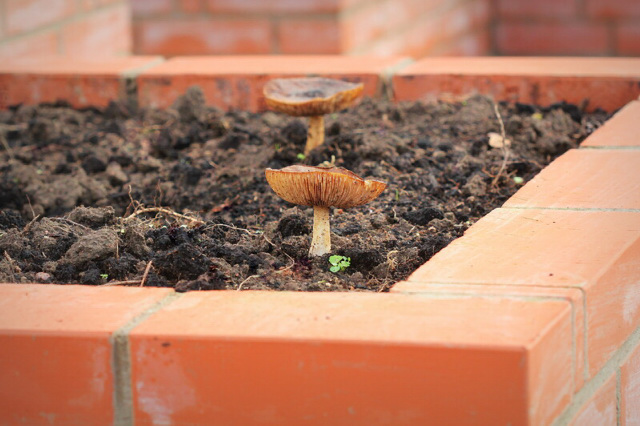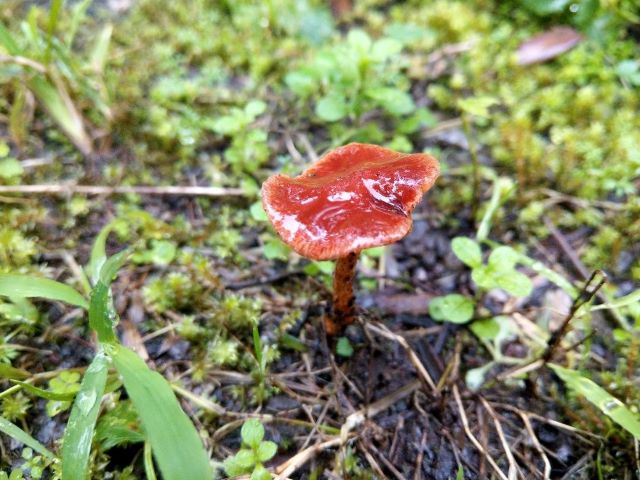The sight of unplanned fungi cropping up in your raised bed might be confusing at first. You might even be worried about what this means for your garden. Are mushrooms in your raised garden bed going to harm your other crops? Why are they appearing in the first place?

The good news is that this is rarely something to worry about. In fact, mushrooms appearing in your raised bed are often an indication that the area is moist, rich in nutrients, and organically healthy. Fungal networks can also be very beneficial for your plants and can help improve the quality of the soil in your garden.
If you want to remove mushrooms because of how they look or because you’re worried about their toxicity, the best way to do so is by hand. You can also help them deteriorate more quickly by breaking them up and burying them.
Related: Soil Calculator For Raised Bed Gardens
Table of Contents
- Firstly, What Exactly are Mushrooms?
- Why are Mushrooms Growing in My Raised Bed?
- What are the Benefits of Mushrooms Growing in My Raised Bed?
- When Should I Be Worried About Mushrooms Growing in My Raised Bed?
- How to Prevent Mushrooms from Growing in Raised Beds
- How to Remove Mushrooms
- Some Favorite Gardening Products
Firstly, What Exactly are Mushrooms?
Mushrooms are the visible parts of complex fungal networks extending through the soil. These sometimes vast networks are made up of numerous small, microscopic threads called mycelium. They are often beneficial both for the fungus and the plants surrounding it.
Mushrooms are the reproductive structures of fungi. They appear when the conditions are ripe for healthy fungal growth. Mushrooms will eventually release spores in order to help spread and propagate new growth.
Humans have come to love and fear the mushroom in sometimes unequal measures. Many species of mushrooms form delicious, succulent, edible produce for a range of dishes, though there are some that are toxic to humans.
The most poisonous mushrooms can, in extreme circumstances, cause death. Picking and eating wild mushrooms is therefore something that only those who are extremely confident in identifying species of fungi should do.

Why are Mushrooms Growing in My Raised Bed?
Mycelia exist in practically all soil, which means there is usually the potential for mushroom growth in any part of your garden. However, mushrooms will appear when fungi feel the conditions are ripe and ready for reproduction to take place. Raised garden beds often provide these conditions in various ways.
Sufficient Moisture
Though raised beds often have better drainage than ground beds, an attentive gardener will make sure they’re well-watered to help the crops grow! This means that the soil is often kept moist, perfect for mushrooms as well as whatever you might be trying to cultivate yourself.
Shaded Areas
Raised garden beds can result in areas of soil being kept in shade for most or part of the day. This is most often the case close to the edges of beds, or in between raised structures. Mushrooms prefer shaded, damp conditions, making these spots ideal grounds for sprouting.
Warmer Soil
Although mycelium will be present throughout nearly all forms of garden soil, mushrooms are likely to appear in slightly warmer conditions. Raised beds will often heat up quicker than ground garden beds and may retain their warmth if covered with fleecing or netting.
Plenty of Organic Matter
Mushrooms will often grow on decaying organic matter which they then feed on for nutrients. This is why you can see them bursting from old tree stumps or aged fencing. Raised garden beds may contain wood chips, chunky mulch, or timber that’s used to build the bed itself. All of these can provide the ideal foundation for mushrooms to sprout from.
What are the Benefits of Mushrooms Growing in My Raised Bed?
We’re still learning about the many ways fungal networks help plants as well as the soil they grow in. What we do know is that, more often than not, mushrooms appearing in your garden are something to be celebrated.
Mycelium networks appear to be able to help plants access certain nutrients, such as nitrogen, potassium, and phosphorus. They do this in exchange for carbon, which fungi need to grow.
There is also growing evidence to suggest that this symbiotic relationship between plants and fungi is a method that plants use to communicate with one another. Certain plants may be able to ‘warn’ others of pest infestations and diseases via these networks.
For example, tomato plants are capable of detecting chemical signals emitted by plants suffering pest infestation before ramping up their own defense systems in response. Though we have known for some time that plants have these mechanisms, it is only relatively recently that scientists have started to glimpse the role that fungal networks might play in helping them function.
Mushrooms also help break down larger, complex chunks of organic matter. This can improve the quality of your soil overall, helping increase the rate that nutrients from organic matter can be absorbed. They are also unlikely to act as huge nutrient drains on your bed and will often add nutrients to the soil once they decompose themselves.
When Should I Be Worried About Mushrooms Growing in My Raised Bed?
Although mushrooms and their underground networks are likely to benefit your garden overall, there may be instances in which you’d prefer to remove them.
Poisonous mushrooms can be an issue if they are growing in a raised bed of edible crops. Fortunately, the species of mushrooms likely to appear in raised beds are more likely to be harmless than toxic. Nevertheless, if you have any doubts, it’s better to be safe than sorry.
Similarly, if you have little ones or pets that can’t be kept away from the garden beds, it may be best to remove any toadstools that could prove irresistible to curious mouths.
How to Prevent Mushrooms from Growing in Raised Beds
You may also decide that you just don’t like the look of these fungal visitors! In this case, there are a number of ways you can try to reduce the chances of mushrooms cropping up.
Use Mature Compost or Manure
Organic material that is still in the process of decomposing can result in heat and humidity, both of which are ideal for mushrooms. Mushrooms also like to grow on organic material that is in the process of decomposing, such as old wood chips or bark. Try using thoroughly decomposed organic material to mulch or fertilize your bed whenever possible.
Use Stone Instead of Timber When Building Your Beds
Many people find that mushrooms appear around the edges of raised beds on the timber structure itself. To guard against this, you can either use wood that has been specifically treated to dissuade fungal growth or go for another material altogether. If you don’t need your beds to be particularly high, stone can be a good, natural alternative to timber.
There’s also the option of treating raised wooden beds yourself. Spraying or brushing the sides with an equal mix of water and vinegar can raise the acidity of the wood. Mushrooms tend to prefer slightly alkaline conditions.
It’s worth bearing in mind that any acidic compounds you apply to the sides of the bed can leach into the soil itself and disrupt the pH. This could in turn prove problematic for any crops you’re trying to grow, as well as the microbial health of the earth. We wouldn’t recommend trying to alter the pH too much just for the sake of curtailing benign mushroom growth.
Improve Drainage and Reduce Shade

Improving the drainage of your soil might help keep damp conditions to a minimum. If you have lined your raised garden bed with material, best to poke small holes in it to help avoid water gathering.
If you find the soil itself is a bit thick and clay-like, mixing fine compost and organic material through it can help reduce water retention.
Mushrooms also love the shade, so you may wish to avoid placing raised beds in overly dark spots. Pruning back overhanging tree branches or looming bushes can also help keep the sun shining down.
How to Remove Mushrooms
You can remove mushrooms by hand simply by picking them off. Use gloves if you are worried about toxicity and make sure to wash your hands thoroughly afterward.
Unless you are extremely confident in identifying edible as well as dangerous species, do not eat any mushrooms that you pick.
You can also use a fork or other garden implement to chop the mushrooms up and grind them back into the soil. Although this may not prevent further mushrooms from sprouting in the future, it can help break down any unwanted growths so that the soil can be fed with nutrients.
Mushrooms are also great for the compost pile, assuming they’re not poisonous.
Related: 30 Surprising Things You Can Compost At Home
Remember, fungi are a natural and important part of our green ecosystems. We are still learning about the many ways underground networks of mycelium can help plants. We also know that fungi help break down organic matter and improve the overall quality of our soil.
If you see them appearing in your garden, it’s probably a good sign. If it’s safe to leave them there, and you don’t mind how they look, then why not let them do their thing?
Some Favorite Gardening Products
- Felco Garden Pruners
- AeroGarden Bounty Indoor Hydroponic Herb Garden
- King Bird Raised Garden Bed
- Sloggers Waterproof Garden Gum Boots
Related Reading:
